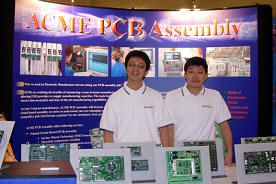Local PCB Assembly house in LA.
The electronic manufacturing services (EMS) industry took off after the late 1970’s. Before this, most electronics manufacturing that was done in large quantity production runs was handled by in-house assembly only.
Now, the electronic manufacturing services (EMS) provider offers more flexibility and easier resources to deal with issues for smaller companies who doing limited runs. An electronic manufacturing services (EMS) provider is able to specialize in large manufacturing, raw materials procurement, and resources.

Since the early 1990’s, the development of Surface Mount Technology (SMT) on PCB has allowed for the rapid assembly of electronics, many electronic components switched to Surface Mount Technology (SMT) from Through hole components. SMT components are making more and more small footage, more and more fine pitch, the equipment for SMT components are requiring more and more accuracy. For small businesses, it is a good idea to outsource your EMS needs.
Outsourcing all your manufacturing needs to a Electronic manufacturing services (EMS) provider helps you to save money, it also helps you to control your overhead cost, which in turn reduces your companies overhead cost. As a result, Electronic manufacturing services (EMS) provider gives you the opportunity to produce your products at a lower cost.
ACME PCB Assembly in Carson, California has been an Electronic manufacturing services (EMS) provider since 1993. OEMs are realizing the benefits of outsourcing versus in-house manufacturing. Outsourcing to Electronic manufacturing services (EMS) provider enables OEMs to concentrate on their core competencies by allowing Electronic manufacturing services (EMS) providers to supply manufacturing expertise. The main benefits of outsourcing include a reduction in costs and investment, additional capacity, shorter time-to-market and state-of-the-art manufacturing capabilities.
As your Contract manufacturer, ACME circuit board assembly will become a business partner who has a vested interest in your success. By outsourcing to ACME circuit board assembly, ACME PCB Assembly strive to understand your ever-changing needs in your specific competitive markets. Our objective is to provide not only quality products with a competitive price but become a partner for our customer, from product design to the distribution process.




